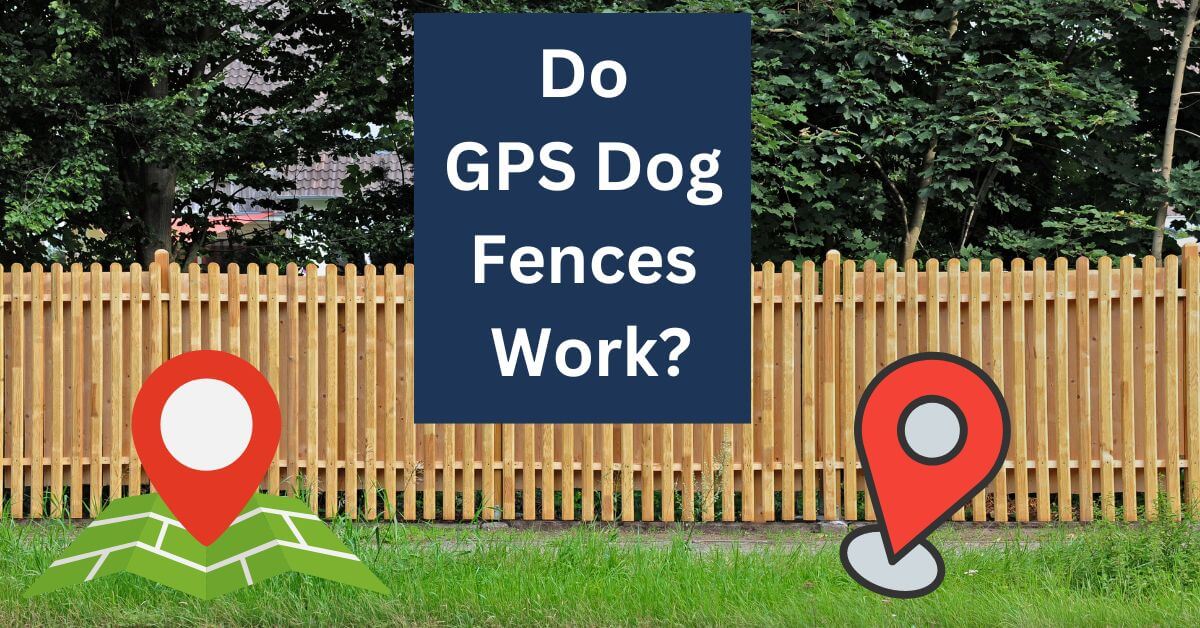GPS dog fences have become increasingly popular over the years to keep dogs contained within a certain boundary, with no need for any physical ground fences. But the question remains, do GPS dog fences work?
While traditional electric dog fences use a physical boundary to keep dogs contained, GPS dog fences create a virtual fence boundary using GPS coordinates.
This means that dogs wear a GPS collar that communicates with a base station, allowing the owner to set up a boundary on a map. When the dog crosses the boundary, the collar emits a warning sound, and if the dog continues to move outside the boundary, it receives a static correction.
While a GPS fence for dogs may seem like a convenient solution for pet owners who don’t want to install a physical fence, there are some concerns about their effectiveness.
GPS coordinates can shift and are prone to interference because of changes in signal strength, which might lead to inconsistencies in the boundary. Certain dogs may also become immune to the static correction over time, which, unfortunately, can render the fence ineffective.
Why consider a GPS Dog Fence?
Most pet parents will want to keep their dogs safe and contained. GPS dog fences offer a convenient and effective solution. Unlike traditional fences, GPS dog fences use a combination of GPS technology and wireless communication to create a virtual boundary for your dog to stay within.
One of the main advantages of a GPS dog fence is that it allows your dog to roam freely within the designated area without being tied up or confined in a small space. This can be especially beneficial for the more active dogs that just love to run and play.
GPS dog fences are normally pretty easy to install and can be set up in a matter of minutes with no special tools or equipment.

Another advantage of a GPS dog fence is that it can be customized to fit the specific needs of your property. Whether you have a large or small yard, they can program a GPS dog fence to create a boundary that is just the right size for your dog to roam within.
You can adjust a GPS-based fence to avoid obstacles such as trees, bushes, and other landscaping features, making it easy to create a boundary that protects your plants or trees from your pets.
There is currently an ongoing debate whether dog urine really damages the health of trees. In my experience, the pee of our dog, Charlie, damaged our arborvitae trees.
We have a row of 16 Arborvitae trees planted on the garden side of our boundary fence. We designed them to provide some shelter from the elements, and also, from an aesthetic perspective, to hide the physical yard fence in the background.
To be fair, nothing happened to the trees for the first few months. However, what was noteworthy was, for whatever reason, the lovely Charlie relieved himself on the same innocent little tree every single day! And it was many times every single day.

Why that tree?
Honestly, I do not know, particularly as there are another 15 Arborvitae trees planted in the same relatively straight line. Perhaps you can see the damage to the bottom of the tree in the photograph? The doggy diddle seemed to damage the lower part of the tree, and as the months went on, it got progressively worse.
If you’re interested in reading some more on the dangers of canine urine to plant health, then check out this article published a few years back.
How Do GPS Dog Fences Work?
GPS dog and pet fences use GPS technology to create a virtual boundary for pets. The system comprises a collar that the pet wears and a base station that is normally placed in the home.
The collar contains a GPS receiver that communicates with the base station. The base station signals the collar, which tells the pet where the boundary is located.
When the pet reaches the boundary, the collar signals the base station, which then signals to the pet in order to stop them in their tracks. The idea behind is that the pet is trained to associate the signal with the boundary and will, therefore, stop when it hears or feels the signal.
GPS dog fences can be a great option of keeping your pets safe and secure in their own yard, with no physical fences or walls. They are pretty easy to set up and use, and they provide a great alternative to traditional physical fences or walls.
They can provide some peace of mind for owners by preventing pets from wandering off and getting lost or hurt. With a GPS dog fence, pet owners can rest easy knowing that their pets are safe and secure in their own yard.
How Effective are GPS Dog Fences?
GPS dog fences have become increasingly popular as an alternative to traditional fences and electric dog fences. While they offer convenience and portability, pet owners may wonder how effective they are in keeping their dogs within a designated area.
The effectiveness of GPS dog fences largely depends on the accuracy and the updating rate of the device. A GPS fence with a high location accuracy and fast updating rate can provide a much more reliable boundary for the dog.
However, if the GPS coordinates are not accurate or the updating rate is slow, the dog may cross the boundary undetected.
The location and the surrounding terrain can also affect the effectiveness of any GPS dog fences. Obstacles such as trees, buildings, and hills, which can cause the location accuracy to fluctuate can affect GPS signals.
It is important for pet owners to consider the surrounding environment where the GPS dog fence is located.
Despite these limitations, GPS dog fences can be effective in several situations. They are useful for pet owners who travel frequently with their dogs or have a large property that is difficult to fence with traditional methods.
However, it is important to note that GPS dog fences are not foolproof and should not be relied on as the sole means of containing a dog. Pet owners should always supervise their dogs and be aware of their whereabouts, even when using a GPS dog fence.
Pros of GPS Dog Fences
GPS dog fences have several advantages over traditional fences and other types of electronic dog fences. Here are some pros of GPS dog fences:
- Portability: GPS dog fences are portable and can be used anywhere, making them ideal for people who travel with their dogs or those who frequently move homes.
- No digging: Unlike traditional fences, GPS dog fences do not require any digging by us humans! Depending which can be time-consuming and expensive.
- No visible fence: GPS dog fences are invisible, which means they do not obstruct the view or detract from the aesthetic appeal of a property.
- No maintenance: GPS dog fences require little to no maintenance, which can nearly always save time and money in the long run.
- Customizable: GPS dog fences can be customized to fit the specific needs of a dog and its owner. For example, they can adjust the boundary to accommodate a larger or smaller area, and they can adjust the correction level to suit the individual dog’s temperament.
GPS dog fences can provide a convenient and effective way to keep dogs safe and contained with no need for traditional fences or physical barriers.
Cons of GPS Dog Fences
While GPS dog fences have their advantages, they also have some notable drawbacks that pet owners should consider before investing in one.
- Signal interference – GPS signals can be affected by several factors and this can cause some interference. You may have some issues if part of your invisible fence is located underneath some heavy foliage or dense tree lines. This can limit the effectiveness of the fence and put your dog at risk of wandering off.
- Power requirements – any GPS dog fences is that they require a power source to operate. This means that you will need to ensure that the device is charged or has access to a power source at all times. If the device runs out of battery or loses power, your dog will be unprotected and may leave the boundary without receiving a correction.
- Cost – GPS fences can, in some instances, be more expensive than other types of dog fences, such as traditional wired or wireless fences. If you have a small yard or garden, then it might make more sense to build a physical fence.
Final Thoughts
GPS dog fences can be an effective solution for keeping dogs within a specific area with no physical fences. However, they are not a one-size-fits-all solution and may not be suitable for every dog and every property.
One of the main advantages of GPS dog fences is their portability, which makes them ideal for areas where traditional fences are not practical or desirable. They can also be useful for owners who want to give their dogs more freedom to roam while still keeping them safe and contained.
Whether a GPS dog fence is the right choice for your dog and your property depends on a variety of factors, including the dog’s temperament, the size and layout of the property, along with the owner’s budget and personal preferences.
While there are some limitations to GPS dog fences, the benefits in most instances outweigh the cons for many dog owners.



